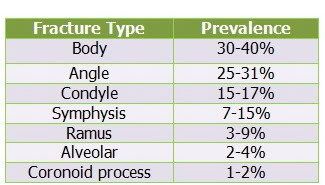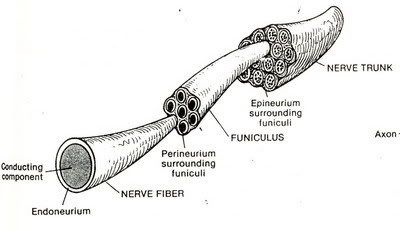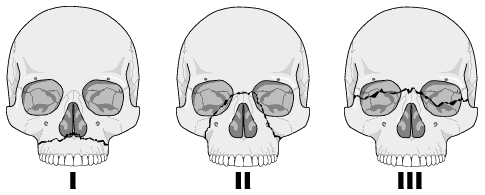
Common site of Mandibular Fractures
Mandible นั้นถือเป็น prominent position ที่มักเกิดการบาดเจ็บได้ง่าย ในสมัยก่อน นั้นมีอุบัติการณ์ประมาณ 2:1 เมื่อเทียบกับ facial bone fracture อื่นๆ แต่หลังจากมี high speed automobile accident มากขึ้น อุบัติการณ์ก็มาใกล้เคียงกัน โดย fracture mandible มี Clinical sign ทั่วๆไปหลายอย่างเช่น facial distortion, malocclusion, abnormal mobility, stepping formation เป็นต้น
โดยปกติแล้วเราถือ fracture mandible อยู่ใน” Ring bone rule” คือกระดูกที่มีลักษณะโค้ง ดังนั้นเมื่อเรา เห็นแนว fracture แห่งหนึ่งจากการตรวจหรือจากภาพรังสีก็ตามทีแล้ว ก็มีโอกาสสูงที่เราจะพบ fracture อีกแห่งหนึ่งในmandible ด้านตรงกันข้าม เนื่องจากลักษณะการกระจายแรงที่มากระทำของกระดูก mandible นี้ นอกจากนั้นยังมีปัจจัยการมี flexibility ของ รูปร่าง mandible รวมไปถึง การ absorb แรงโดย TMJ
จากกฎข้างต้น Fracture mandible นั้นจึงอาจเกิดเป็น double fractures ได้เช่น bilateral sides of symphysis ,combination include angle mandible plus contralateral body or condyle ส่วน triple fracture นั้นก็อาจเกิดขึ้นได้เช่น fracture both condyle and symphysis ครับ
สุดท้ายมีข้อคิดแถมอยู่ใน website นะครับ - Wise saying about Mandibular fracture
- คำนึงถึง “Ring bone Rule” เอาไว้
- Panoramic film นั้นนับเป็น single film ที่ใช้ตรวจดู fracture mandible ได้ดีมาก
- สังเกตโดยรอบของ cortical margin of mandible เพื่อหา discontinuities( fracture line) line
- อย่าลืมสังเกตดูว่ามี discontinuities of inferior alveolar canal หรือไม่
- Fracture line ที่ผ่าน root นั้นเรานับเป็น open fracture
- Mandibular Fractures นั้นยังมีสาเหตุหลายอย่างที่มากกว่า trauma เช่น Pathologic fracture นั้นสามารถเกิดขึ้นได้ จาก ทั้ง tumor, infection เช่น osteomyelitis
Article from http://www.geocities.com/omfsesan/facialfracture.htm
Relate links
Diagnosis Image Facial Fracture
Maxillary fracture




